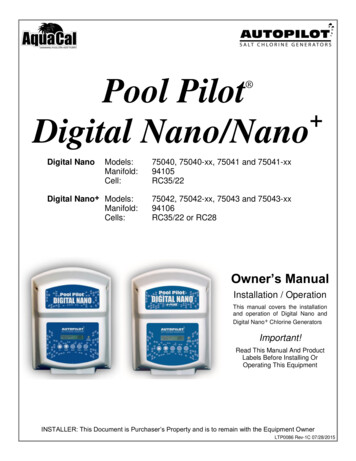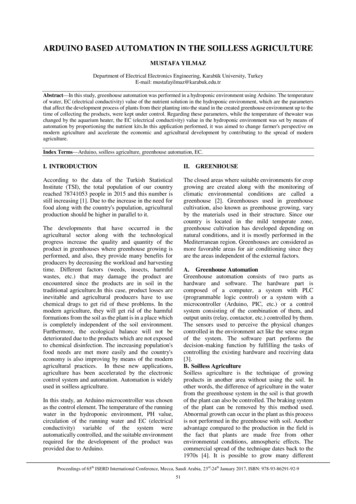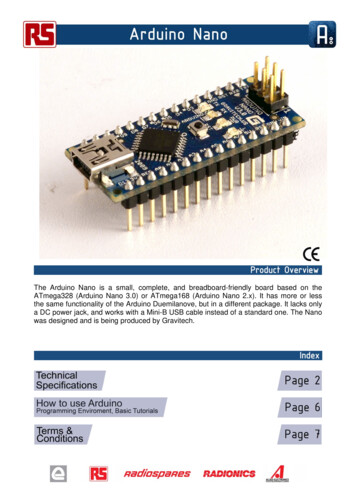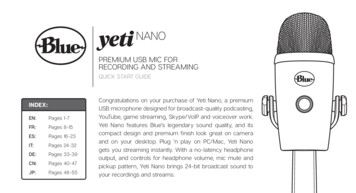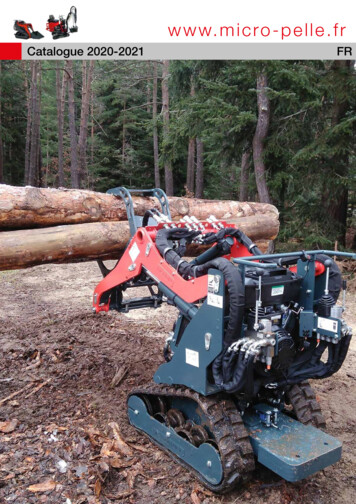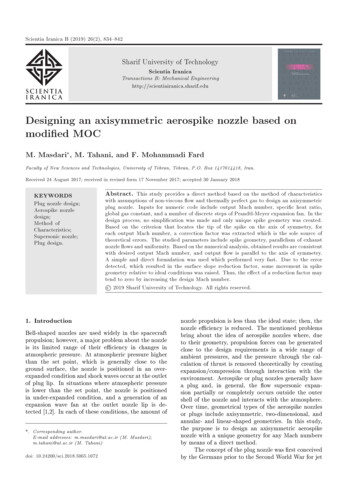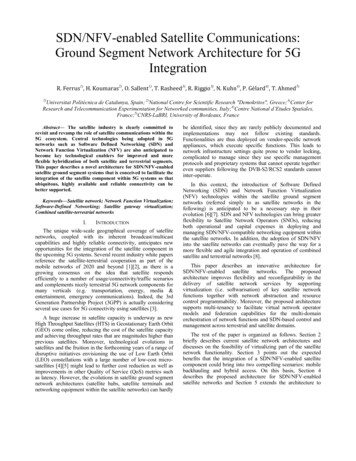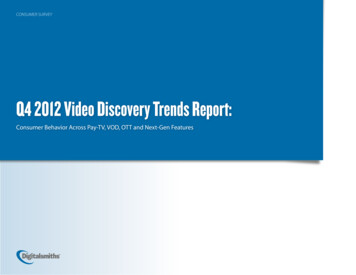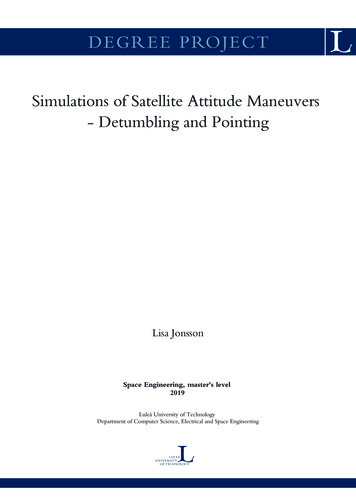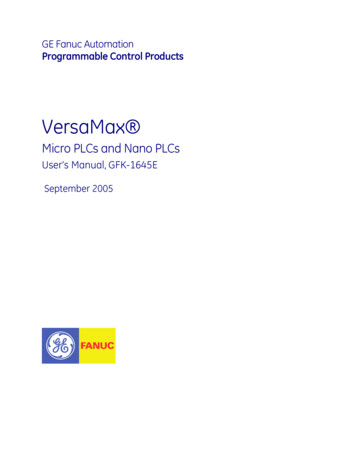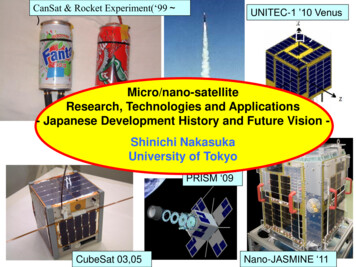
Transcription
UNITEC-1ハイブ‟10 VenusCanSat & Rocket Experiment(‘99 ch, Technologies and Applications- Japanese Development History and Future Vision Shinichi NakasukaUniversity of TokyoPRISM „09CubeSat 03,05Nano-JASMINE „11
Japanese Space Development by JAXAMany SatellitesH-IIA Rocket(11 ton to LEO)ISS participation- JEM- HTV
Contents Japanese University‟s History of Micro/nano /picosatellite development Recent stepping-up from education to practical use New program for micro/nano-satellite developmentand utilization with “reasonably reliable systems(Hodoyoshi)” concept Future vision: How micro/nano-satellites can beused for business, Earth monitoring, or humanwelfare, etc.
Emerge of Nano/pico-Satellites in JapanSuccess of CubeSat(1kg)by Univ. Tokyo and Titech(2003.6.30)––––University level budget (30K )Development within 2 yearsSurviving in space for 8 yearsGround operations, frequencyacquisitions, launch opportunitysearch processed by ourselves1 50kg (Micro/Nano/pico-sat):Starting from education buthigher level satellites appearsCubeSat XI-IV & XI-VRussianLaunch
Starting Point:CanSat (since 1999)
Educational Significances ofMicro/Nano/Pico-Satellite Projects Practical Training of Whole Cycle of Space Project Importance for Engineering Education Synthesis (not Analysis) of an really working systemFeedbacks from the real world to evaluate design, test, etc.Learning from failures (while project cost is small)Education of Project Management Mission conceptualization, satellite design, fabrication,ground test, modification, launch and operationKnow what is important and what is not.Four Managements: “Time, human resource, cost and risk”Team work, conflict resolution, discussion, documentationInternational cooperation, negotiation, mutual understandingAlso contributions to other technology areas !
University of Tokyo‟s Historyof Nano/pico-satellite Developments2003110405 06 07 0812091020m GSD Remote SensingEducation,camera testCubeSat XI-IV(ROCKOT) 2003/6Astrometry (top-science)PRISM(H-IIA) 2009/1NANO-JASMINE5m GSD Remote Sensing(CYCLONE-4) 2011Education,CIGS solar cellsCubeSat XI-V(COSMOS) 2005/10HODOYOSHI-12012Developmentlaunch
CubeSat “XI-IV (Sai Four)”Mission: Pico-bus technology demonstration in space, Camera experimentDeveloper: University of TokyoLaunch: ROCKOT (June 30, 2003) in Multiple Payload Piggyback LaunchSizeWeightAttitude control10x10x10[cm] CubeSat1 [kg]Passive stabilization withpermanent magnet and damperOBCCommunicationPIC16F877 x 3VHF/UHF (max 1200bps)amateur frequency bandPowerCameraMission lifeSi solar cells for 1.1 W640 x 480 CMOSmore than 8 yearsCaptured Earth Images and Distribution to Mobile Phones
CubeSat “XI-V (Sai Five)”Mission: CIGS solar cell demonstration, Advanced camera experimentDeveloper: University of TokyoLaunch: COSMOS (October 27, 2005) deployed from “SSETI-EXPRESS”SizeWeightAttitude control10x10x10[cm] CubeSat1 [kg]Passive stabilization withpermanent magnet and damperOBCCommunicationPIC16F877 x 3VHF/UHF (max 1200bps)amateur frequency bandPowerCameraMission lifeSi, GaAs, CIGS cells640 x 480 CMOS 5 yearsT-POD deploymentSystemSSETI-EXPRESSJAXA/NEDO CIGSSolar CellsDeployed fromSSETI-EXPRESSin spaceCaptured Earth Images
PRISM “Hitomi”Mission: Earth Remote Sensing (20 m GSD, RGB) with Deployable BoomDeveloper: University of TokyoLaunch: H-IIA (Jan 23, 2009) Piggyback with GOSAT (CO2 monitoring sat)Size20x20x40[cm] in rocketWeightAttitude control20x20x80[cm] in space8.5 [kg]3-axis stabilization withSun, Magnet sensor, MEMS gyromagnetic torquersOBCCommunicationMission lifeSH2, H8 x 2, PIC x 2VHF/UHF (max 9600bps) 2.5 yearsCaptured imagesMexico SeashoreUS DesertKita-Kyushu (Japan)Wide Angle Camera
The Nile leCamera)
Nano-JASMINEMission: Astrometry (Getting precise 3D map of stars and their movements)Developer: University of Tokyo, National Astronomical Observatory of Japan,Shinshu University, Kyoto UniversityLaunch: Cyclone-4 (planned within 2013) from Alcantara Launch SiteSizeWeightAttitude control50 [cm-cubic]33 [kg]3-axis stabilization withStar, Sun, Magnet sensor, FOG,RW, Magnetic torquersOBCCommunicationMission lifeFPGAS-band 100 [kbps]2 [year]Special features:-Attitude Stability 0.8 arcsec for 8.8 sec-Thermal Stability 0.1K (at -50 degree)-Map Accuracy Compatible with“Hipparcos” Satellite („89)-Telescopetwo CCDs with TDI
WNISAT-1Missions: Iceberg observation in Arctic Ocean, Atmospheric Observation (CO2)Developer: AXELSPACE, Weathernews Inc.Please visit:Launch: DNEPR (2012) e control27x27x27[cm]15 [kg]3-axis stabilization withSTT, SAS, Magnetometer, GyrosRW, magnetic torquersOBCCommunicationCameraLaserMission lifeFPGAUHF (max 38.4 kbps)Visible & NIR, GSD 500mCO2 absorbed (1.55 m)2 yearsComponents by AXELSPACEGlobal Iceberg MonitoringExperiment of CO2 density measurementStar SensorCoarse Sun Sensor(AxelStar)(AxelSun)More info available at our website!
UNISEC (UNIversity SpaceEngineering Consortium) Founded in 2002, became NPO in 2003 56 laboratories from 36 universities: 500 students 220 individual and company supporting members UNISEC Missions:– Education and human resource training for spacedevelopment/utilization– Innovative space technology “seeds” development Activities to be Supported:––––Joint experiment, joint development, joint education, etc.Workshop, symposium, technology exchange, etc.Consultation on legal matters (frequency, export law, etc.)Finding “rivals” within the community !http://www.unisec.jp
UNISEC Satellites DevelopmentHokkaidoInstitute ofTechnologyNihon UniversityThe University of TokyoTokyo Institute of TechnologyXI-ⅣSEEDS(FM1)Cute-ⅠHITSATCute-1.7 APDXI-ⅤTokyo Institute ofTechnologyThe University of Apr.Tohoku UniversityNihon CKSATKagoshimaUniversityPRISMCute-1.7 APDThe Universityof TokyoTokyo Institute ofTechnologyKKS-1STARSKagawa UniversityTokyoMetropolitanCollege OfIndustrialTechnologyWASEDA-SAT2Waseda UniversityNegai ”Soka University
From Education to Practical Use Satellite development process should be changed– Workload concentrated (trial-and-error) style Systematic development style– University competition university collaboration,including more small/medium industries– Establish “technology pool” for all the components– From “educational reliability” to “customer reliability”– Establish an environment where universities pursuetechnology innovation while industry pursue nonadvanced technology conservation Aiming at all-Japan consortium where eachuniversity or company participates with its strength Mission creation is essential
Governmental “First” Programselected as one of 30 science andtechnology research projectsin Japan (2010-2014)New Space Development and UtilizationParadigm by Nano-satellites IntroducingJapan-oriented “Reasonable ReliableSystems (Hodoyoshi) Engineering”Project LeaderShinichi NakasukaSchool of Engineering, University of Tokyo
Problem of mid-large Satellites4.0Trend towardslarger satellites3.5Weight ton3.02.5( 2.0) 1.51.0ALOS(4t)・Enormous cost 100M ・Development period 5-10 years・Conservative design・Almost governmental use・No new users and utilizationideas・Low speed of innovationSELENE(3t)10-50M Micro/NanoSatellites 50kg1-5M
“Hodoyoshi” Micro/Nano-sat Project OverviewMid-large satellite based spacedevelopment and utilization- Many fundamental drawbacksParadigm Shift by Micro/Nano-sat- Low cost / fast development time- New users / new utilization areasResearch Themes1. Theoretical research on “Reasonably Reliable” Systems Engineering- Hodoyoshi aims at not ultimate performance and reliability but some reliability is stillneeded2. Innovation of component technologies to solve the “size” problems- Novel ideas / concepts using new physics/electronics/dynamics, etc.3. Innovation of Micro/Nano-satellite architecture consideringstandardization, modularity and Hodoyoshi development process- Adequate and sufficient process to obtain so-so performance should be searched4. All Japan micro/nano-satellite consortium establishment to combineJapanese universities’ and small business’ competences, alsocreating user communities
Innovation in Component Technologies and ProcessOptical光ビームComm. System①Advanced technologiesin all - component pools in ��間の汎用可動式光通信- high performance/sizehigh �目標30Mbpsの可能性RF to optical linkを確認 将来は軌道上実証実験)②Novel concepts- new idea for each function- new satellite architecture③Process 度10control秒、制御精度30subsystem:秒 将来は安定制御精度1 ��高強度材料、easyto熱制御素材develop andanalyze- standardization to reducecost/development る望遠鏡などで利用されてい- test ��て超小型衛星搭載がin-orbitcompensation, etc to耐放射線性に優れた半導体おtolerant high可能になるサイズにする手法等。 radiation- software re-useよびFPGAを利用(目標:aim for 2.5m (final) to 5m(目標:分解能5m 従来の200kg衛星の能力 将来は2m目指す)(initial)ground �験不要、高anddata link速衛星内通信
Tentative Image of Project Target Practical (but not maximum)-quality satellite withlow cost and short development timeex.)ground resolution: 5m (initial) 2.5m (final) Develop and make available all the requiredmicro/nano-sat components within Japan– World wide Bench-marking of all the componenttechnologies have been made and we aim at top levelquality in terms of “performance/size” Satellite bus cost 3M development time 1.5 year– Process and component innovation required
Missions Creation for Hodoyoshi Program Low-cost and small size realizesatellite constellation– More frequent (ex. semi-daily)observation of the same areas Formation flightConstellation ofa hundred satellites– Many scientific applications such asinter-ferometer, multi-site observation,stereo vision “Personal Satellite” “My Satellite”– Novel ways of utilization includingentertainment, education, contents, etc– Just like “PC and internet” innovationwhich has changed the worldStereo Vision“Furoshiki” satellite
Personal satellite: Those interested in UT’s CubeSat successEven nano-satellites can do lots of task in space.developedPossibility of missions which have never beencreated for large cost satellites. - - Education companies(space contents) - Local government(good for younggeneration science education. Comm. link at disaster time) ---------- Equipment manufacturers(advertisement by space demo.) Amateur astronomers(Space telescope they can use freely) Weather forecast company(Own information)( WNIsat) Space organization/companies (quick In-orbit test bench)( XI-V solar cell test)
Creation of Mission Ideas Is important !- 2nd Mission Idea Contest (MIC2) The Mission Idea Contest has beenestablished since 2010 foraerospace engineers, collegestudents, consultants, and anybodyinterested in innovative spacedevelopment from all over the world.Regional Coordinators are working ineach region.The objective of the contest is toencourage innovative exploitation ofnano-satellites to provide useful andsustainable capabilities, services ordata. The 2nd contest will be held inNagoya in October 10, 2012.http://www.spacemic.net
Satellite Development Plan (5 sats within 4 years)#1:5m GSD forpersonal use– Data is open to privateusers so that they cantest their utilizations(developed by AXELSPACE)Port 1(B lu e b an d )Port 4(N IR b an d )Port 3(R e d b an d)Port 2(G r e e n b an d )To be launched in 2012#2:Foreign space science mission– Mission selection is under wayfrom 14 candidates(developed by Tohoku University)#3:Constellation of 2 or 3 satellites– Data sales, business trial, etc.– Conceptual design is just started(developed by Univ. Tokyo and NESTRA)Searching forco-launch (4 x 50kg)opportunity in2013 4Q - 2014 1Q
HODOYOSHI-1Mission: Earth Remote Sensing (5m GSD, 4 bands: RGB & NIR)Developer: AXELSPACE, University of Tokyo, NESTRALaunch: Foreign Rocket in 2012SizeWeightOBCCommunicationMission life50 [cm-cubic]50 [kg]FPGAUHF, X (max 20 Mbps)2 [year]Attitude control3-axis stabilization withSTT, SAS, Magnetometer, Gyros,RW, Magnetic torquers- stability0.1 deg/sec- pointing accuracy 5 arcmin- determination10 arcsecOptical sensor:15kg, 5m GSD (500km alt.)- Focal length740mm (F# 7)- IFOV24.3 x 16.2 km (500km alt.)- Bands(SNR)B(103), G(119), R(84), NIR(63)- Onboard storage 8GB ( 100 compressed images)Mission instrumentsdeveloped by Genesia Corporation
OrbitLEOGSD5 m (at 500km alt.)RefractionOpticsFocal length(for Hodoyoshi-1)Maximum CapturedArea24.3km 240km (by 16 consecutiveimages along track)Wavelength bandsBlueGreenRedNIR: 0.45um - 0.52um: 0.52um - 0.60um: 0.63um - 0.69um: 0.76um - 0.90umSNR@ solar elevation is30deg / 60deg,albedo re range foroptimal imagingperformanceAdvancedfunctionality740mm (designed for above GSD)724.3km 16.2km per image77896246/ 103/ 119/ 84/ 63 15kg for the sensorTc 10K (or broader : based on opticalathermalization technology. Tc is designed to be 20 degree for this optics)* TDI(Time Delay Integration) for improvedSNR* Internal calibrator of radiance levels.
2012/2/17超小型衛星 GISワークショップExample:Rapid Eye6mGSD28
Example of FootprintsSwath: 24.3kmsatellite‟s velocitye.g., 81km with five images(maximum 16 images)Kanto plain in Japan (c) 2010 Google
Capacity Building Support ProgramUNIFORM (UNiversity International FOrmation Mission) Each country develops one microsatellite ( 50kg)(Funded by MEXT, Japan)– To be operated in constellation manner– Standardization of bus/component– Training of satellite development issupported by Japanese Universities– Equipment cost partially supported byJapanese government (in negotiation) Ground Station Network– Low-cost GS is developed to realize oneGS in each country (S/X-band) Missions– Common mission individual mission– Common mission will be determined bydiscussions within communityPossibility: one or two 50kg satelliteslaunch in every two years since 2013Operation in constellation
UNIFORM Satellite Specification
Summary Japanese universities‟ progress fromeducation to practical use– From CanSat, CubeSat to space science,remote sensing, technology demonstration New program to seek for paradigm shift bymicro/nano-satellites– Development process innovation to assurelow-cost and quick development– Importance of creation of missions suitable formicro/nano-satellites Micro/nano-satellites will change the spacedevelopment/utilizations with their strength
Intelligent Space Systems LaboratoryInnovative Nano-Satellite Technology Center(Nakasuka Laboratory)Department of Aeronautics and AstronauticsUniversity of Tokyohttp://www.space.t.u-tokyo.ac.jpNESTRA(Next Generation Space Systems TechnologyResearch Association)http://www.nestra.jp
2 monitoring sat) Size 20x20x40[cm] in rocket 20x20x80[cm] in space Weight 8.5 [kg] Attitude control 3-axis stabilization with Sun, Magnet sensor, MEMS gyro magnetic torquers OBC SH2, H8 x 2, PIC x 2 Communication VHF/UHF (max 9600bps) Mission life 2.5 years Mexico Seashore US Desert Kita-Kyushu (Japan) Wide Angle Camera
